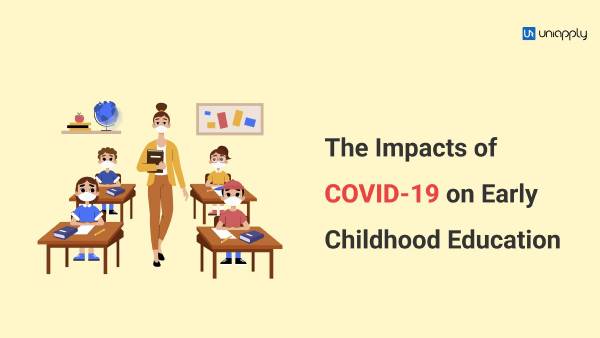The Impact of COVID-19 on Early Childhood Education
Introduction
Education plays a particularly significant role in children and adolescents’ health and well-being and has a lasting impact on their lives as adults. There is little question that the global health pandemic has caused unprecedented disruption to all spheres of human life and to education worldwide. UNESCO, estimates that 1.2 billion school children had their education put on hold due to COVID-related school closures and, between late March through April of 2020, more than 90% of the total enrolled learners worldwide experienced nationwide school closures and were confined at home. In many ways, adapting to COVID-19 has become a huge, international social experiment that not only has caused loss of learning throughout lockdown but also can be expected to diminish educational opportunities in the long term.
It is a fact that early childhood years in a person’s life are the most crucial in terms of development of physical, sensorimotor, social, emotional, linguistic and cognitive faculties. Brain development is most rapid in these years and the rest of a person’s life in terms of learning and development is greatly determined by how they are nurtured in this phase. Several longitudinal studies have displayed high correlation between early childhood programmes and a better future, for instance, in terms of attainment of higher education, better employment and lower crime rate. Losing out on receiving the appropriate developmental inputs at this stage of their lives is bound to have a detrimental impact on the lives of millions of children across the world. Participation in high-quality early childhood education and care (ECEC) is essential for the personal development, social integration, successful lifelong learning and later employability of all children.
World Health Organization (WHO)Declared a global pandemic on 11 March 2020 by the World Health Organization (WHO), COVID-19 has had far-reaching impacts on every facet of life around the world, exacerbating pre-existing inequalities and negatively impacting on vulnerable and disadvantaged populations the most. The COVID-19 world health crisis has profound implications for the care and education of young children in homes and schools, the lives of preservice and in-service teachers, and the work of college/university faculty. Between March 12 and 27, 2020 a survey of educators from 89 countries identified the following priorities: ensuring academic learning for students, supporting students who lack skills for independent study, providing support for teachers (medical, mental health, professional development), revising graduation policies, ensuring integrity of the assessment process, defining new curricular priorities, and providing social services and food to students. Among the concerns identified by this same international group of educators were:
- Reduced opportunities for social interaction with extended family, peers, and community members.
- Threats to the health and safety of students, families, and educators.
- Financial decisions about education and program viability.
- Disruptions to the continuity of learning.
- Limited access to social services and other forms of support for families.
- Negative effects on students perception of the value of study.
- Drastic reductions in face-to-face teaching and instructional time.
- Implementation of measures to continue students’ learning during school closure.
- Teachers’ preparedness to support digital learning.
- When and how to reopen schools.
- Reductions in class size.
- Mobility of students and legal status of international students.
- Ways to provide practical, field experiences, and apprenticeships for professionals in training.
The global response to Coronavirus Disease 2019 (COVID-19) has changed daily life in many ways for many people. Yet child development has not paused, and supporting children, families, and care providers of all kinds is as important as ever. The unfavourable circumstances unleashed by COVID-19 have not spared anyone, but the impact of it has been felt differently by different groups of people. For no other group does it have a permanent, irreversible, and irredeemable effect as in the case of children between 3-6 years.
The Pandemic and its Impact on ECEC (Early Childhood Education and Care)
In response to the ongoing COVID-19 pandemic, countries around the world have taken unprecedented steps in an effort to prevent and contain the spread of the virus. Some of these containment measures have included closures of schools and childcare services, lockdowns and guidelines for physical distancing, shutting down of non-essential businesses, and suspension of community and recreation services and programmes. The ripple effects of such actions and the impact on families and societies is now being felt, and seen, in very real ways including strain on healthcare systems, a pending economic crisis, food and housing insecurity, and social upheaval. These disruptions to everyday life mean that many young children are at home unable to attend early childhood education and care and are therefore now entirely reliant on their caregivers for nurturing care and to meet all of their developmental needs (physical, emotional, social and cognitive). This added burden on families to balance childcare and work responsibilities, compounded by economic instability and social isolation in many cases, is fertile ground for home environments characterized by toxic stress. We know that optimal brain development requires a stimulating and enriching environment, adequate nutrition, learning opportunities and social interaction with attentive caregivers. Under the current pandemic context, access to these opportunities will likely be severely restricted, compromising the healthy developmental trajectory of many children. Unsafe conditions, negative interactions and lack of educational opportunities during the early years can lead to irreversible outcomes, which can affect a child’s potential for the remainder of his or her life. Of course, the opposite pattern could also emerge such that we witness an increase in responsive and nurturing care provided to children as caregivers spend increasing amounts of time in the home and are less engaged in work and social activities outside the home.
Three powerful ideas that bind the field of early childhood education and care together need to become part of the international educational landscape. They are: (1) early childhood represents an irreplaceable opportunity for growth, development and learning; (2) the experiences of young children are formative and exert an influence across the lifespan; and (3) taking positive action during the early years can prevent more serious issues later on. The fervent hope is that COVID-19 provides a rare opportunity to create a stronger, more equitable and humanitarian society. The world needs to move beyond vague assertions about young children’s rights and political rhetoric about children representing our future. Instead, the global community needs to demonstrate–through major financial commitments and enlightened policies and practices—that the care and education of the very young is an international priority. Also the major effects that can be seen are as follows-
- Physical development- Access to outdoor space is important for physical activity and mental health, as well as opportunities to play and socialise. Play promotes cognitive, physical, social and emotional well-being in young children. Concerns have been raised by academics and charities throughout the pandemic about the limited opportunities for children to play and engage in physical activity due to pandemic restrictions.
- Social, emotional and behavioural development and mental health- Due to the pandemic, there has been an overall deterioration in mental health and well-being of the children and young people during the pandemic.
- Cognitive development- They found that during this period of increased time at home with caregivers, children who had less passive screen time and whose caregivers read to them during lockdown showed larger gains in vocabulary size, compared to pre-lockdown age-matched peers, after controlling for socio-economic status.
- The COVID-19 pandemic has impacted the ECEC sector in a number of ways, including temporary and permanent setting closures, reduced demand for ECEC places and workforce challenges.
- The finances of childcare providers were already weak in several parts of the sector before the pandemic. Despite government support to the sector during COVID-19, closures and reduced demand have increased financial pressures and stakeholders have raised concerns about the pandemic’s long-term impact on financial sustainability.
- Prior to the pandemic, there were long-term issues recruiting and retaining staff, especially highly qualified staff. This has been exacerbated by the pandemic and some stakeholders have expressed concerns that this could compromise the quality of ECEC in the long term.
- Available evidence suggests that changes in access to ECEC has impacted pre-school children in a number of ways, including social, emotional and behavioural development and mental health, physical development and school readiness. However, evidence also suggests that children and families have experienced the pandemic in very different ways, which has shaped any impacts on development, both positive and negative.
- Negative impacts on children’s development and mental health from changes in access to ECEC are more likely for disadvantaged children and children with Special Educational Needs and Disabilities (SEND), as well as vulnerable children.
The Way Forward – A New Normal
ECE is a time-sensitive matter. Therefore, it is critical, not only for the future of the children, but of the entire society, that this matter be addressed urgently, and alternatives be devised promptly and children begin to receive the vital pre-school education.
Experts contend that the ongoing ECE infrastructure has collapsed under COVID-19. Six months since the pandemic struck India, the question of how to ensure vital ECE to the children is still looming large. It has been emphasised that ECE has to be reimagined for the short to medium run by employing all strategies possible. Five of them are discussed here.
- Firstly, the need of the hour is positive parenting. Parents’ involvement must increase in the process. SOPs must be designed whereby teachers/AWWs give training to parents on how to ensure that the child receives the required ECE. Wherever possible, online classes involving both parents and children can also be planned. Availability of time is the biggest concern here, especially in cases where both parents are working and taking on domestic duties as well. Policies for income/livelihood support will go a long way in ensuring that parents participate in the ECE process.
- Second, is education through an online medium. Children so young should have very limited or no screen-time. Recently, the government of Karnataka banned online classes for children up to fifth standard. Apart from its ill-effects on the child’s health, there is the question of exclusion. A wide disparity persist when it comes to access to computers or mobile phones with an internet connection in Indian households. Civil rights experts have emphasised that the online mode cannot be considered a viable alternative for ECE for a vast majority of India’s children, particularly those in the rural areas. There is also a gender divide when it comes to accessibility to devices and technology. Despite these issues, this has evolved as one of the strongest alternatives to face-to-face teaching during the pandemic.
- Third, AWWs can reach out to children by employing novel approaches and practicing social distancing norms, for example, in open air classrooms instead of indoor classrooms and meeting children in small clusters throughout the day in batches. These approaches can be experimented with in green zones.
- Fourth, children should be reached out via the traditional media – television and radio. This will increase accessibility to a great extent when compared to computer and internet based solutions and Kerala has already started streaming classes for older children via television.
- And lastly, the government needs to step in and step up. ECE has been discussed in the New Education Policy 2020, but governments must step in by figuring out what needs to be done. It should involve experts in the area and formulate SOPs for the current situation. Also, attention should be given to a long standing demand of the civil society, that of amending the Right to Education Act to bring ECE under its ambit. The Government also needs to step up funding for ECE significantly, which has been emphasised by a recent UNICEF report as well.
Few months have passed and there are no signs of the pandemic subsiding anytime soon. It is a pressing need of the hour that all possible approaches be employed according to feasibility, and the children receive what is owed to them for a better tomorrow. This throws a lot of challenges, and needs a wider stakeholder involvement but it is the responsibility of the adult community to ensure the invisible rights of children, and not lose any more precious time.
Conclusion
Both the immediate and long-term negative effects of the pandemic on children’s health and development are likely to disproportionately affect families in communities with high concentrations of poverty, lack of access to quality healthcare and affordable childcare, food and housing insecurity, and limited services for family support. Similarly, the ongoing crisis is likely only to exacerbate the situation of children living in home environments characterized by a lack of access to developmentally appropriate resources, such as toys and books, low levels of stimulation and responsive care, or inadequate supervision prior to the crisis. Also, it may be unrealistic to expect caregivers, particularly those with low levels of education or limited caregiving skills to begin with, to be able to offset the resulting gaps from children’s lack of attendance to education and other care opportunities.
Mitigating the negative impact of COVID-19 on young children will require strategic multi-sectoral approaches and the synergy of interventions in health, nutrition, security, protection, participation and early education.
The current pandemic has exposed the inadequacy of our systems and responses. “The pandemic’s disproportionate, tragic consequences for health and livelihoods—for individuals, their communities, and even whole societies—underscore institutionalized forms of discrimination rooted in race, ethnicity, class, gender, sexual orientation, age, and abilities” . Even as vaccinations are being rolled out, it is obvious that there are “haves” and “have nots” and practices/policies that serve to perpetuate bias and exclusion. Grappling with COVID-19 has made it clear that mental and physical health are indivisible. Ideally, in the aftermath of the pandemic, societies worldwide will begin working toward linking mental and physical health support services, particularly for marginalized and vulnerable groups.






